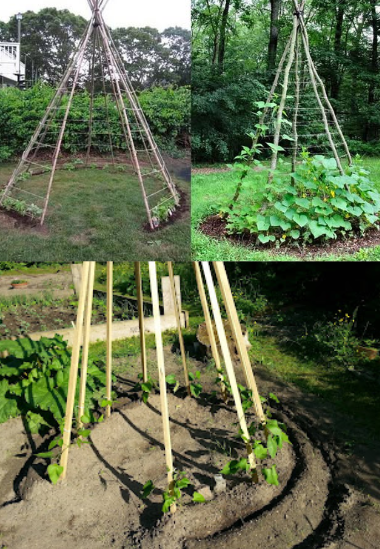
Cucumbers are garden royalty—crisp, refreshing, and easy to grow. But what if you could make your cucumber patch more productive, healthier, and better looking—all at once? Enter the herringbone pattern, a clever gardening technique that turns your average cucumber bed into a high-yield, organized powerhouse. Let’s break down why this method works wonders and how to get it growing in your own backyard.
Why the Herringbone Pattern Changes the Game
Think of the herringbone layout as nature’s blueprint meets design brilliance. Here’s why it’s such a game changer:
- Maximizes Space: Instead of crowding cucumbers in straight rows, the diagonal pattern makes room for more plants without chaos.
- Boosts Air Circulation: Air can freely move between the plants, keeping things fresh and reducing disease risks like powdery mildew.
- Improves Sunlight Access: Every leaf and vine gets its fair share of sunshine—no more struggling for light.
- Makes Harvesting Easier: The pattern creates natural pathways and visibility, making it a breeze to spot ripe cukes.
- Looks Stunning: Honestly, it’s just visually satisfying. Your garden will turn heads.
So, ready to ditch the old row method and level up your cucumber game? Let’s dig in.
Plan Your Garden Like a Pro
Before you even pick up a trowel, good planning will save you headaches later.
Pick the Perfect Spot
Cucumbers love the sun. Choose a sunny patch of your garden that gets at least 6–8 hours of direct light a day. No shade, no compromise.
Soil Matters
Prep your soil like you’re setting the table for a picky guest. It should be:
- Well-draining so the roots don’t rot
- Rich in organic matter (add compost or rotted manure)
- Slightly acidic to neutral (aim for pH 6.0 to 7.0)
Map the Spacing
Each cucumber plant needs space to thrive. Plan on 18 inches of room all around each plant. The herringbone pattern uses that space wisely while avoiding a tangled mess.
Build Your Herringbone Frame
This is where your garden becomes a masterpiece.
Gather Your Tools
You’ll need:
- Bamboo or wooden stakes
- Garden twine or netting
- Hammer or mallet
- Optional: zip ties or soft plant ties
Assemble the Pattern
- Place two rows of stakes, about 18 inches apart.
- In each row, tilt the stakes diagonally so they form ‘X’ shapes when viewed from the side.
- Bind the tops where the stakes intersect—this is the skeleton of your herringbone structure.
- Repeat the X-pattern every 18 inches down the row.
- Use twine or netting across the structure to give your vines something to climb.
Voila—you now have a living trellis that’s as strong as it is stylish.
Video : Growing CUCUMBERS Herringbone (Part 1)
Plant and Train Your Cucumbers Like a Gardener Ninja
This is where things get exciting—planting day!
Sow the Seeds
Plant 1–2 cucumber seeds at the base of each X structure. Press them about an inch deep and water thoroughly. Keep the soil moist (not soaked) until they sprout.
Guide the Growth
As the vines start stretching out:
- Gently wrap them around the stakes or tie them loosely with soft ties
- Avoid tugging or bending too hard—think dance partner, not wrestling match
- Prune side branches if it starts to get too bushy; you want vertical energy
The goal here is tidy, upward growth that takes full advantage of your beautiful herringbone layout.
Care That Keeps Your Plants Thriving
Growing is only half the battle—maintenance is what turns good gardens into great ones.
Water Wisely
Cucumbers are thirsty. They want consistent moisture, especially during flowering and fruiting. Water at the base to avoid wetting the leaves, which invites disease.
Feed to Succeed
Apply a balanced fertilizer every 4–6 weeks to keep your plants fueled and productive. Bonus tip: fish emulsion or compost tea adds an extra nutrient kick.
Keep Pests in Check
Watch for:
- Aphids
- Cucumber beetles
- Powdery mildew
Use neem oil or a homemade garlic spray as natural protection. And remember—happy plants resist pests better.
Harvest Time: The Reward for All That TLC
This is what it’s all about—biting into that perfect, crunchy cucumber you grew yourself.
Know When to Pick
Don’t wait too long. Cucumbers are best when they’re:
- Medium-sized
- Firm
- Bright green
If you leave them too long, they get bitter and seedy. Trust your gut—if it looks ready, it probably is.
Harvest Gently
Use a sharp knife or scissors to cut them from the vine. Don’t yank—rough handling damages the plant and slows future growth.
Video : easy way to make cucumber trellis 👌👍🏿
Conclusion
Growing cucumbers in a herringbone pattern isn’t just smart—it’s a total garden glow-up. You’ll grow more in less space, enjoy healthier plants, and make your backyard look like a pro-designed farm. From the satisfying symmetry of the layout to the smooth, abundant harvests, this method just makes sense.
So next time you think about planting cucumbers, skip the old straight rows. Try the herringbone pattern. Your plants—and your tastebuds—will thank you.


